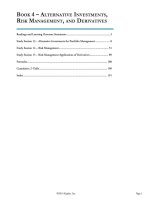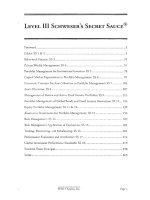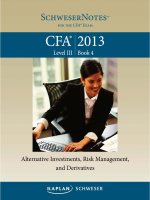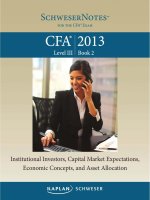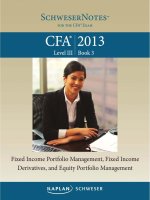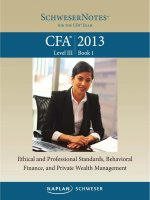2019 CFA level 3 qbank r 26 27 intro to equity port managem passive equity invest answers
Bạn đang xem bản rút gọn của tài liệu. Xem và tải ngay bản đầy đủ của tài liệu tại đây (676.67 KB, 14 trang )
10/12/2018
Learning Management System
Question #1 of 26
Which portfolio construction method is most likely to be used when tracking an index with a
large number of constituent stocks for relatively small clients?
A) Full replication.
B) Strati ed sampling.
C) Optimization.
.in
Explanation
(Study Session 13, Module 27.2, LOS 27.d)
Related Material
Question #2 of 26
bo
ok
c
SchweserNotes - Book 4
en
tre
Full replication is more di cult and less e ective the larger the number of constituent stocks,
and smaller clients are less able to a ord the costs of optimization.
m
An investment analyst is addressing environmental, social, and governance (ESG) concerns for
.o
clients. Her goal is to recommend suitable investments by excluding companies from the equity
investment universe that fail to meet client ESG standards. Which of the following screening
w
w
techniques should be applied by the investment analyst?
A) Negative screening.
w
B) Thematic investing.
C) Positive screening.
Explanation
Negative screening (i.e., exclusionary screening) excludes companies or sectors that do not
meet client standards. Positive screening (i.e., best-in-class screening) seeks to uncover
companies or sectors that rank most favorably with clients. Thematic investing screens
equities based on a speci c theme.
(Study Session 13, Module 26.1, LOS 26.a)
Related Material
SchweserNotes - Book 4
/>
1/14
10/12/2018
Learning Management System
Question #3 of 26
Which of the following statements regarding using equities as an in ation hedge is most
accurate? They have been a good in ation hedge:
A) in many countries over a short time span.
B) but only in the U.S for a short time span.
C) in many countries over a long time span.
.in
Explanation
(Study Session 13, Module 26.1, LOS 26.a)
Related Material
Question #4 of 26
bo
ok
c
SchweserNotes - Book 4
en
tre
Using data for 17 countries for 106 years, equities have had consistently positive real returns
(i.e., their nominal return has been higher than that of in ation).
m
An investment analyst is evaluating portfolio costs related to buying and selling equity
.o
securities. Which of the following costs is an example of an implicit trading cost?
w
w
A) Stock exchange fees.
B) Broker commissions.
w
C) Price impact from trading.
Explanation
Trading costs can be explicit or implicit. Explicit costs include broker commissions, stock
exchange fees, and taxes. Implicit costs include bid-ask spreads, price impact from the
transaction, and delay costs from not completing an entire trade due to illiquidity. Price
impact measures the e ect on market prices from making a trade.
(Study Session 13, Module 26.2, LOS 26.c)
Related Material
SchweserNotes - Book 4
/>
2/14
10/12/2018
Learning Management System
Question #5 of 26
The strategy of using derivatives to shift a portfolio back to the risk exposure that matches the
index as a result of short-term deviations is best referred to as:
A) a rebalancing overlay.
B) a completion overlay.
C) a risk overlay.
Explanation
Related Material
Question #6 of 26
bo
ok
c
SchweserNotes - Book 4
en
tre
(Study Session 13, Module 27.2, LOS 27.c)
.in
Completion overlays using derivatives can move the portfolio back to the risk exposure of the
index if it deviates in the short-term, for example, by adjusting the portfolio's beta to match
the index beta.
m
Management fees and trading commissions are most likely to be lowest for:
A) passive factor-based investing.
.o
B) active investing.
w
w
C) market-cap weighted passive investing.
Explanation
w
Management fees and trading commissions are highest for active investing and lowest for
market-cap weighted passive investing.
(Study Session 13, Module 27.1, LOS 27.b)
Related Material
SchweserNotes - Book 4
Question #7 of 26
Which of the following is least accurate regarding using equities as an in ation hedge?
/>
3/14
10/12/2018
Learning Management System
A) The historical record is impressive as to their e ectiveness.
B) Their ability to hedge is una ected by taxes.
C) The e ectiveness of an individual stock as a hedge depends on its product market.
Explanation
Because corporate income and capital gains tax rates are not indexed to in ation, in ation
can reduce the stock investor's return, unless this e ect was priced into the stock when the
investor bought it. Equities have had consistently positive real returns in 17 countries from
1900-2005. The more competition in a rm's product market, the less e ective their stock will
be as a hedge.
(Study Session 13, Module 26.1, LOS 26.a)
.in
Related Material
en
tre
SchweserNotes - Book 4
bo
ok
c
Question #8 of 26
Which of the predominant weighting schemes used in the construction of equity share indices
assumes that the investor holds each company in the index according to its relative weight in
the index?
m
A) The market capitalization-weighted index.
.o
B) The free oat-adjusted market capitalization index.
w
w
C) The price-weighted index.
Explanation
w
The market capitalization-weighted index, also known as the value-weighted index, assumes
that the investor holds each company in the index according to its relative weight in the
index. The price-weighted index assumes that the investor holds one share of each stock in
the index.
(Study Session 13, Module 27.1, LOS 27.a)
Related Material
SchweserNotes - Book 4
Question #9 of 26
/>
4/14
10/12/2018
Learning Management System
Passive factor-based investing is also referred to in the industry as:
A) strati ed investing.
B) smart beta.
C) attribution trading.
Explanation
Portfolio returns can be explained by factor models, so one way to replicate the return/risk
characteristics of an index is to create a portfolio with the same exposures to a set of risk
factors as the index. This strategy is often referred to as a passive factor-based strategy (also
known as smart beta).
.in
(Study Session 13, Module 27.1, LOS 27.b)
Related Material
bo
ok
c
Question #10 of 26
en
tre
SchweserNotes - Book 4
Which of the following is least accurate regarding equities in a portfolio?
A) Equities have been shown to be an in ation hedge worldwide.
m
B) European institutions hold more equity than U.S. institutions in their portfolio.
w
w
Explanation
.o
C) U.S. equity typically constitutes about half of world equity.
w
In the U.S., institutional investors hold about 60% of their portfolio in equity. In Europe, the
percentage is closer to 20%. The historical evidence in the U.S. and in other countries
indicates that equities have been a good in ation hedge.
(Study Session 13, Module 26.1, LOS 26.a)
Related Material
SchweserNotes - Book 4
Question #11 of 26
/>
5/14
10/12/2018
Learning Management System
If an optimization approach to portfolio construction yields a portfolio that is not meanvariance e cient relative to the benchmark, the most appropriate solution to this problem is
to:
A) re-estimate the key inputs to the model: returns, variances, and covariances.
B) add a constraint that portfolio volatility is equal to benchmark volatility.
C) switch to full replication.
Explanation
.in
One drawback of the optimization approach is that it can create portfolios that are not meanvariance e cient relative to the benchmark. The solution is to add a constraint that total
portfolio variance is equal to the volatility of the benchmark.
en
tre
(Study Session 13, Module 27.2, LOS 27.d)
Related Material
Question #12 of 26
bo
ok
c
SchweserNotes - Book 4
The use of free- oat weighting for a market-cap weighted portfolio most likely has the largest
m
positive e ect on which characteristic of indexes?
w
w
B) Rules-based.
.o
A) Transparent.
C) Investable.
w
Explanation
Free- oat weighting calculates market caps excluding closely held shares not available to
market participants for trading and therefore improves the investability of the index.
(Study Session 13, Module 27.1, LOS 27.a)
Related Material
SchweserNotes - Book 4
Question #13 of 26
Which of the following statements is most accurate?
/>
6/14
10/12/2018
Learning Management System
A) Corporate governance issues are important to passive investors.
B) Passive investors typically have little or no access to corporate boards and
management.
C) The cost of voting proxies for passive investors typically outweighs the bene ts, so
portfolio managers of passive funds don’t usually exercise the right to vote those
i
Explanation
(Study Session 13, Module 27.3, LOS 27.f)
Related Material
Question #14 of 26
bo
ok
c
SchweserNotes - Book 4
en
tre
.in
Investor activism and engagement between larger shareholders and corporate boards and
management is a key function of active portfolio management. Passive investors can't sell
shares if they are unhappy with the management and leadership of a company, so corporate
governance matters to them as well. Even passive portfolio managers have a duciary duty to
vote proxies, so whether the costs outweigh the bene ts or not, they can't ignore that
responsibility. They do often use proxy-voting services to reduce the cost of researching the
issues.
m
Which of the following equity investment portfolios would most likely be passively managed?
.o
A) USA consumer defensive sector portfolio.
w
w
B) Emerging markets small-cap value portfolio.
C) World large-cap growth portfolio.
w
Explanation
An appropriate equity portfolio benchmark should contain a broad range of underlying
securities with su cient liquidity. These factors will enhance the potential for benchmark
outperformance while keeping trading costs at a reasonable level. For these reasons, country
and sector-speci c equity funds (e.g., consumer defensive companies) tend to be more
passively managed.
(Study Session 13, Module 26.2, LOS 26.e)
Related Material
SchweserNotes - Book 4
/>
7/14
10/12/2018
Learning Management System
Question #15 of 26
Three market-cap weighted indexes have the following Her ndahl-Hirschman indexes (HHI):
HHI for Index XX = 0.01.
HHI for Index YY = 0.05.
HHI for Index ZZ = 0.10.
Which of these market-cap weighted portfolios has the same concentration risk as an equally
weighted portfolio of 100 stocks?
A) Index YY.
.in
B) Index XX.
en
tre
C) Index ZZ.
Explanation
bo
ok
c
The inverse of the HHI measures a portfolio's concentration risk, and that inverse can be
interpreted as the e ective number of stocks in a portfolio. The e ective number of stocks
for index XX is 1 / 0.01 = 100. In other words, if you had an equal weighted portfolio of 100
stocks, its HHI would also be 0.01.
(Study Session 13, Module 27.1, LOS 27.a)
Related Material
.o
m
SchweserNotes - Book 4
w
w
Question #16 of 26
w
Which type of analysis is most useful in identifying sources of tracking error?
A) Attribution analysis.
B) Optimization.
C) Strati ed sampling.
Explanation
The manager of a passively managed equity portfolio needs to understand the sources of
return versus the index in order to e ectively and e ciently manage a portfolio that
replicates its performance. A key tool is attribution analysis, which can help the manager
identify the sources of tracking error.
(Study Session 13, Module 27.3, LOS 27.f)
/>
8/14
10/12/2018
Learning Management System
Related Material
SchweserNotes - Book 4
Question #17 of 26
Which fund most likely has the lowest tracking error relative to its benchmark?
Fund Alpha: Fees = 0.11%; cash allocation = 4.2%
Fund Beta: Fees = 0.02%; cash allocation = 1.6%
.in
Fund Gamma: Fees = 0.06%; cash allocation = 2.1%
en
tre
A) Fund Alpha.
B) Fund Beta.
C) Fund Gamma.
bo
ok
c
Explanation
Lower fees and a smaller cash allocation result in lower tracking error, all else equal.
(Study Session 13, Module 27.3, LOS 27.e)
Related Material
.o
m
SchweserNotes - Book 4
w
w
Question #18 of 26
w
Which of the following indices would be biased towards small cap stocks?
A) An equal-weighted index.
B) A price-weighted index.
C) A value-weighted index.
Explanation
The equal-weighted index is biased towards small-cap companies because they will have the
same weight as large-cap rms even though they have less liquidity. Many equal-weighted
indices also have more small companies in them than large rms, creating a further bias
towards small companies. Value-weighted indices are biased towards large cap stocks and
price-weighted indices are biased towards high priced stocks.
(Study Session 13, Module 27.1, LOS 27.a)
/>
9/14
10/12/2018
Learning Management System
Related Material
SchweserNotes - Book 4
Question #19 of 26
An investor who seeks to actively in uence speci c companies is least likely to:
A) be an activist investor.
B) lend securities.
.in
C) start a proxy voting.
en
tre
Explanation
bo
ok
c
When shares are loaned out, voting rights are transferred to the stock borrower. Being
unable to vote reduces the investor's ability to in uence the company. Activist investors by
de nition seek to in uence the companies they invest in, and launching a proxy ght is one
way they may do so.
(Study Session 13, Module 26.2, LOS 26.d)
Related Material
m
SchweserNotes - Book 4
w
w
.o
Question #20 of 26
An investment advisor is considering the addition of equity securities to one of his client's
portfolios. According to the client's investment policy statement, the client exhibits a low
w
tolerance for risk and prefers stable portfolio income. Which type of equity security would be
most appropriate given this client's investment considerations?
A) Mid-cap oil-producing company.
B) Large-cap consumer staples company.
C) Small-cap technology company.
Explanation
/>
10/14
10/12/2018
Learning Management System
Investing in companies that pay regular dividends, such as large, well-established rms,
would be most suitable for this client's conservative risk and return objectives. Small
technology rms are most likely focused on growth opportunities, so they would be more
appropriate for an aggressive portfolio. Commodity-producing companies may o er a hedge
against in ation, but this investment is less suitable for a conservative portfolio than a largecap consumer staples company.
(Study Session 13, Module 26.1, LOS 26.a)
Related Material
.in
SchweserNotes - Book 4
en
tre
Question #21 of 26
Which of the following statements regarding a free oat-adjusted market capitalization index is
least accurate?
A) A free oat-adjusted market capitalization index assumes the investor has bought
bo
ok
c
all the publicly available shares of each company in the index.
B) The major value-weighted indices in the world have not been adjusted for free
oat.
C) The oat adjusted index is considered the best index type by many investors,
.o
Explanation
m
because it is representative and can be mimicked with minimal tracking risk.
w
w
The major value-weighted indices in the world have been adjusted for free oat.
(Study Session 13, Module 27.1, LOS 27.a)
w
Related Material
SchweserNotes - Book 4
Question #22 of 26
The fact that rms with greater market capitalization have a greater impact on the index than
rms with lower market capitalization creates a primary bias in what type of index?
A) Equal-weighted index.
B) Price-weighted index.
/>
11/14
10/12/2018
Learning Management System
C) Value-weighted index.
Explanation
Value-weighted indices' primary bias is toward large rms that may be mature and/or
overvalued. This bias is a result of these large rms having a greater impact on the index
than rms with lower market capitalization.
(Study Session 13, Module 27.1, LOS 27.a)
Related Material
.in
SchweserNotes - Book 4
en
tre
Question #23 of 26
A portfolio manager is planning to invest in an emerging market's small-cap index. Which of the
following equity universe segmentation approaches does this market index combine?
bo
ok
c
A) Size/style and geographic segmentation.
B) Geographic and economic activity segmentation.
C) Size/style and economic activity segmentation.
Explanation
.o
m
An index that tracks small-cap companies from emerging markets combines size and style
segmentation with geographic segmentation. Economic activity segmentation groups
companies into sectors or industries.
w
w
(Study Session 13, Module 26.1, LOS 26.b)
Related Material
w
SchweserNotes - Book 4
Question #24 of 26
A portfolio manager is considering investing in a startup rm with a price-to-earnings (P/E) ratio
of 42. The manager notes that the market P/E ratio is currently 25. Which of the following
equity investment style boxes would best categorize this company?
A) Small-cap value.
B) Large-cap growth.
/>
12/14
10/12/2018
Learning Management System
C) Small-cap growth.
Explanation
Given the startup nature of this company, it most likely has a small market capitalization.
Also, given the company's high P/E ratio relative to market, it is likely more growth focused
than value focused. Therefore, this company would be best categorized as small-cap growth.
(Study Session 13, Module 26.1, LOS 26.b)
Related Material
.in
SchweserNotes - Book 4
en
tre
Question #25 of 26
A wealth manager is researching the potential sources of income from owning and managing
an equity portfolio. Which of the following actions are required if the manager wishes to
bo
ok
c
generate income from a dividend capture strategy? The manager should:
A) sell put options on equities.
B) transfer equities to another investor.
C) buy-and-hold equities for a short period of time.
m
Explanation
w
w
.o
With a dividend capture strategy, an investor buys a stock right before its ex-dividend date
and holds that stock through the ex-dividend date. After the dividend is received (i.e.,
captured), the manager immediately sells the stock. Transferring equities between investors
is a form of securities lending. Selling put options on equities while simultaneously
depositing money into a separate account is a cash-covered put.
w
(Study Session 13, Module 26.2, LOS 26.c)
Related Material
SchweserNotes - Book 4
Question #26 of 26
Active management may demand or provide liquidity to equity markets. Which of the following
active investment strategies would most likely demand liquidity from the market?
A) Momentum strategies.
/>
13/14
10/12/2018
Learning Management System
B) Deep value strategies.
C) Buy-and-hold strategies.
Explanation
Momentum strategies tend to demand liquidity from the market by buying shares in an
increasing market and selling shares in a decreasing market. Strategies that invest in
undervalued securities are more like contrarian strategies that provide market liquidity. Buyand-hold strategies are passive in nature and don't speci cally demand or supply liquidity.
(Study Session 13, Module 26.2, LOS 26.c)
Related Material
w
w
w
.o
m
bo
ok
c
en
tre
.in
SchweserNotes - Book 4
/>
14/14
